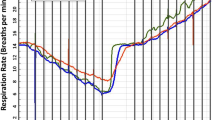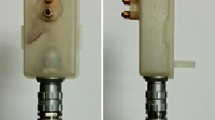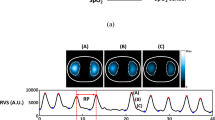Abstract
To compare respiration rate measurement by an acoustic method and thoracic impedance to capnometry as the reference method, in patients at the Emergency Department after drug or alcoholic poisoning. In this observational study, 30 patients aged 18 or older, hospitalized at the Emergency Department for drug or alcoholic poisoning, without any contraindication to a face mask and/or a cervical acoustic sensor, were included in the study. They benefited from a simultaneous recording of their respiration rate by the acoustic method (RRa®, Masimo Corp., Irvine, CA, USA), by thoracic impedance (Philips Intellivue® MP2, Suresnes, France) and by capnometry (Capnostream® 20, Oridion, Jerusalem, Israël) through a face mask (Capnomask®, Mediplus Ltd, Raleigh, NC, USA) for 40–60 min. Of the 86,578 triplets collected, 77,155 (89.1 %) were exploitable. Median (range) respiration rate measured by capnometry was 18 (7–29) bpm. Compared to capnometry, bias and limits of agreement were 0.1 ± 3.8 bpm for the acoustic method and 0.3 ± 5.5 bpm for thoracic impedance. The proportions of RR values collected by acoustic method or by thoracic impedance which differed over 10 or 20 % during more than 15 s, compared to capnometry, were 8.3 versus 14.3, and 1.5 versus 3.8 %, respectively (p < 0.0001). The acoustic sensor had to be repositioned on three patients. For 11 patients, the Capnomask® was removed several times. In patients with drug or alcoholic poisoning, the acoustic method seems more accurate than thoracic impedance and better tolerated than face mask capnometry.


Similar content being viewed by others
References
Pouyanne P, Haramburu F, Imbs JL, et al. Admissions to hospital caused by adverse drug reactions: cross sectional incidence study. BMJ. 2000;320:1036.
Bordet R, Gautier S, Le Louet H, et al. Analysis of the direct cost of adverse drug reactions in hospitalised patients. Eur J Clin Pharmacol. 2001;56:935–41.
Folke M, Cernerud L, Ekström M, et al. Critical review of non-invasive respiratory monitoring in medical care. Med Biol Eng Comput. 2003;41:377–83.
Keidan I, Gravenstein D, Berkenstadt H, et al. Supplemental oxygen compromises the use of pulse oximetry for detection of apnea and hypoventilation during sedation in simulated pediatric patients. Pediatrics. 2008;122:293–8.
Fu ES, Downs JB, Schweiger JW, et al. Supplemental oxygen impairs detection of hypoventilation by pulse oximetry. Chest. 2004;126:1552–8.
Petterson MT, Begnoche VL, Graybeal JM. The effect of motion on pulse oximetry and its clinical significance. Anesth Analg. 2007;105:S78–84.
Wilkinson JN, Thanawala VU. Thoracic impedance monitoring of respiratory rate during sedation—Is it safe? Anaesthesia. 2009;64:455–6.
Cohen KP, Ladd WM, Beams DM, et al. Comparison of impedance and inductance ventilation sensors on adults during breathing, motion, and simulated airway obstruction. IEEE Trans Biomed Eng. 1997;44:555–66.
Drummond GB, Nimmo AF, Elton RA. Thoracic impedance used for measuring chest wall movement in postoperative patients. Br J Anaesth. 1996;77:327–32.
Brouillette RT, Morrow AS, Weese-Mayer DE, et al. Comparison of respiratory inductive plethysmography and thoracic impedance for apnea monitoring. J Pediatr. 1987;111:377–83.
Mimoz O, Benard T, Gaucher A, et al. Accuracy of respiratory rate monitoring using a non-invasive acoustic method after general anaesthesia. Br J Anaesth. 2012;108:872–5.
Ramsay MAE, Usman M, Lagow E, et al. The accuracy, precision and reliability of measuring ventilatory rate and detecting ventilatory pause by rainbow acoustic monitoring and capnometry. Anesth Analg. 2013;117:69–75.
Autet L, Frasca D, Pinsard M, et al. Evaluation of acoustic respiration rate monitoring following extubation in ICU patients. Br J Anaesth. 2014;113:195–7.
Bland JM, Altman DG. Agreement between methods of measurement with multiple observations per individual. J Biopharm Stat. 2007;17:571–82.
Critchley LA, Lee A, Ho AM-H. A critical review of the ability of continuous cardiac output monitors to measure trends in cardiac output. Anesth Analg. 2010;111:1180–92.
Gaucher A, Frasca D, Mimoz O, et al. Accuracy of respiratory rate monitoring by capnometry using the Capnomask® in extubated patients receiving supplemental oxygen after surgery. Br J Anaesth. 2012;108:316–20.
Sesay M, Tauzin-Fin P, Verdonck O, et al. Clinical evaluation of the Capnomask in the supine vs. prone position during monitored anaesthesia care. Eur J Anaesthesiol. 2008;25:769–71.
Maddox RR, Williams CK, Oglesby H, et al. Clinical experience with patient-controlled analgesia using continuous respiratory monitoring and a smart infusion system. Am J Health Syst Pharm. 2006;63:157–64.
Friesen RH, Alswang M. End-tidal PCO2 monitoring via nasal cannulae in pediatric patients: accuracy and sources of error. J Clin Monit. 1996;12:155–9.
Goudra B, Penugonda L, Speck R, et al. Comparison of acoustic respiration rate, impedance pneumography and capnometry monitors for respiration rate accuracy and apnea detection during GI endoscopy anesthesia. Open J Anesthesiol. 2013;3:74–9.
Voscopoulos CJ, MacNabb CM, Freeman J, et al. Continuous noninvasive respiratory volume monitoring for the identification of patients at risk for opioid-induced respiratory depression and obstructive breathing patterns. J Trauma Acute Care Surg. 2014;77:S208–15.
Voscopoulos CJ, MacNabb CM, Brayanov J, et al. The evaluation of a non-invasive respiratory volume monitor in surgical patients undergoing elective surgery with general anesthesia. J Clin Monit Comput. 2014. doi:10.1007/s10877-014-9596-0.
Acknowledgments
The study was funded by the University Hospital of Poitiers. Masimo Corp. supplied the Radical-7 Pulse CO-Oximeters and the sensors for RRa measurements. The manufacturer had no input into the design or conduct of this study or in the decision to submit the manuscript for publication.
Conflict of interest
Denis Frasca and Olivier Mimoz received lecture fees and travel expenses from Masimo Corp.
Ethical standard
The study was conducted according to the clinical study protocol (EuDRACT Protocol# 2012-A00868-35), after local ethic committee agreement, the current International Conference on Harmonisation (ICH) Good Clinical Practice (GCP) guidelines, and the 1964 Helsinki declaration and its latter amendments.
Author information
Authors and Affiliations
Corresponding author
Rights and permissions
About this article
Cite this article
Guechi, Y., Pichot, A., Frasca, D. et al. Assessment of noninvasive acoustic respiration rate monitoring in patients admitted to an Emergency Department for drug or alcoholic poisoning. J Clin Monit Comput 29, 721–726 (2015). https://doi.org/10.1007/s10877-015-9658-y
Received:
Accepted:
Published:
Issue Date:
DOI: https://doi.org/10.1007/s10877-015-9658-y




